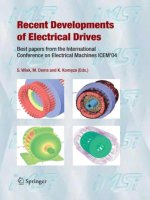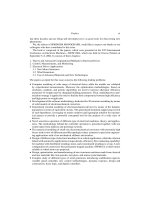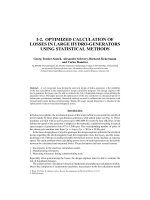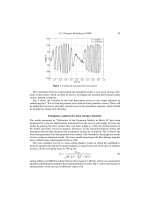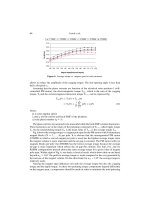Recent Developments of Electrical Drives - Part 2 docx
Bạn đang xem bản rút gọn của tài liệu. Xem và tải ngay bản đầy đủ của tài liệu tại đây (57.83 KB, 10 trang )
Preface xi
last three decades and are being still developed serve as good tools for discovering new
phenomena.
We, the editors of SPRINGER MONOGRAPH, would like to express our thanks to our
colleagues who have contributed to this issue.
The book is composed of the papers, which were presented at the XVI International
Conference on Electrical Machines—ICEM’2004, which was held in Cracow, Poland, on
September 5–8, 2004. It consists of three chapters:
1. Theory and Advanced Computational Methods in Electrical Drives
2. Control, Measurements, and Monitoring
3. Electrical Drives Applications
3.1 New Motor Structures
3.2 Wind Generators
3.3 Use of Advanced Materials and New Technologies
The papers accepted for this issue concerns the following leading problems:
r
Computer modeling of wide range of electrical drives while the models are validated
by experimental measurements. Moreover the optimization methodologies, based on
stochastic, gradient, and genetic algorithms are used to increase alternator efficiency
and power-to-weight ratio by changing building parameters. Then, multiobjectives opti-
mization strategy is applied in order to find the best compromise between high efficiency
and high power-to-weight ratio.
r
Development ofthesoftwaremethodology, dedicated for 3D structure modeling bymeans
of solid models of electromechanical converters.
r
Generalized circuital modeling of electromechanical devices by means of the lumped-
parameters in terms of equivalent circuits. The generalized treatment suppressing several
of such hypotheses, leveraging on matrix notation and lagrangian notation for mechan-
ical aspects to provide a powerful conceptual tool for the analysis of a wide class of
devices.
r
Novel sensorless operation of different type of electrical machines, theory, and applica-
tions. The methodology behind the controller operation is presented together with test
results taken from industry and prototype systems.
r
The numerical modeling of small size electromechanical converters with extremely high
forces with review of different possible topologies rotary actuators in precision engineer-
ing applications with a low mechanical stiffness and ironless.
r
Designofdifferenttypeofelectricalmachinesfora vehicleapplication,whilethecriterion
linkedwithautomotiveapplications(torque density, efficiency, fluxweakening capability)
for machine with distributed windings stator, and concentrated windings is set up. A new
configuration of atransverse-flux permanent-magnet machine (TFPM)fora wheel-motor
suitable as wheel motor are proposed.
r
Design, optimization, and manufacturing of newstructures machines made fromclassical
and new materials like iron-powder, met-glass, and microcrystal materials.
r
Complex study of different types of wind generators introducing stabilization aspects,
variable speed controller, new control methodologies, dynamic response, design and
construction, fuzzy logic, and digital controllers.
xii Preface
r
Application of artificial intelligence (fuzzy logic and neural networks) in modeling and
control of drive systems.
r
Monitoring in real time (on line) while dedicated expert systems are implemented.
S. Wiak
M. Dems
K. Kom
˛
eza
Institute of Mechatronics and
Information Systems,
Technical University of Lodz,
Stefanowskiego 18/22
90-924 lodz, Poland
kom
˛
SECTIONI
THEORY AND ADVANCED
COMPUTATIONAL METHODS
IN ELECTRICAL DRIVES
Introductory Remarks
The papers selected to first chapter are mainly focused on recently developed theory and
computational techniques applied to modeling, simulation, and design of electrical drives.
The papers accepted for this chapter concerns the following leading problems:
r
An analysis of the core losses under no-load conditions in turbine generators by utilizing
a three-dimensional magnetic field calculation based on a finite element method. The
analysis consists of two steps. First, we calculate the loss in laminated steel sheets from
experimental data obtained with an Epstein frame. In the calculation the differences
between the actual core loss and cataloged data, and as well the additional losses in metal
parts other than the steel sheets are taken into account. Basing on the analysis results the
total calculatedcorelosseswithmeasuredvaluesfortwoturbine generators are compared.
r
The optimization of the loss calculation in a design program for salient pole synchronous
machines, as very important issue of the design of hydro-generators reliability. Statisti-
cal methods are used to calibrate the loss calculation with measurements made during
commissioning. Special importance is attached to the optimization of the no-load elec-
tromagnetic losses.
r
A coupled model for accurate representation of the characteristics of permanent magnet
synchronous motors, and proposed the determination of the direct axis reactance, “Xd”,
and the quadratureaxisreactance, “Xq”, by calculus and texts with the permanentmagnet
synchronous machine under generator duty. The starting and synchronization processes
of the PMSM and the influence that on transient behavior of the motor produce different
values of the main motor parameters is analyzed.
r
A dynamic model of the Vernier Hybrid Machine (VHM), for use as a linear generator in
a wave energy converter, has been presented and verified using near sinusoidal displace-
ment data. The model forms the basic building block to investigate the performance and
control of direct drive wave energy converters. A dynamic model capable of predicting
the machine’s behavior for this kind of mechanical excitation. Simple equivalent circuit
models have been also found.
r
A comparative study for permanent magnet synchronous motor (PMSM) with buried
V-shape magnets and for a motor with unusual designed with U-shape magnets in every
second pole is performed.
r
Thechoiceofthe magnetblocks numberoverapole must beconsideredasan optimization
parameter acting on local phenomena such as the cogging torque and higher torque
S. Wiak, M. Dems, K. Kom
˛
eza (eds.), Recent Developments of Electrical Drives, 1–2.
C
2006 Springer.
2 Introductory Remarks
harmonics in PM motors. The technique that consists on the choice of an appropriate
number of magnet blocks over a magnet pole cannot be done without considering the
main parameters, which impose the principal machine performances such as the average
torque. In addition to the reduction of the cogging torque and high torque harmonics, and
reducing eddy currents inside the magnets as well.
r
The numerical model for three-dimensional field analysis of electrostatic micromotors
with stator and rotor symmetry axes located in different points. The proposed algorithm
based on the mesh overlapping allows avoiding the mesh to be generated for the whole
model and decrease the time of computation. Reduction of this time can be obtained
by using separated submeshes for both stator and rotor generated only once, and only
recalculating the part describing the air gap.
r
A compound drive simulator is invented, where a finite element method (FEM) model
of the electric motor is coupled with a frequency converter model and a closed-loop
control system. The method is implemented for SIMULINK and applied on a 2 MW
asynchronous machine drive. The results are validated by measurements and the perfor-
mance is compared with an analytical motor model. It is proved that simulation with
the FEM model provides very good results and gives much better insight in the motor
behavior than the analytical model.
r
An intuitive approach to the analysis of parasitic effects with particular emphasis on
torque ripple. The approach is based on the notion of space phasor modeling. A good
approximation is achieved in predicting the nature and the magnitude of torque ripple by
the use of a relatively simple time-domain model.
r
An analytical multiphysical model—electromagnetic, mechanic, and acoustic—in or-
der to predict the electromagnetic noise of a permanent magnet synchronous machine
(P.M.S.M.). The experimental design method, with a particular design: “trellis design”,
is used to build response surfaces of the noise with respect to the main factors. These
surfaces can be used to find the optimal design or more simply, to avoid unacceptable
designs of the machine, in term of noise for a variable speed application.
r
Numerical methods of calculating the electromagnetic forces and of simulating the oscil-
lation behavior of the stator end winding are introduced. The end winding oscillations of
differentturbo generators under forcedvibrationsarecomputedin a combined simulation.
Also eigen-frequencies and eigen-modes are determined. Numerical simulation of oscil-
lation behavior is found a useful tool in end winding design although model parameter
identification still offers improvement potential.
r
The design procedure of a drive consisting of a voltage supplied brushless motor and a
lead screw transformation system. In order to reduce the cost and the weight of this drive
an optimization of the main dimensions of each component considered as an interacting
part of the whole system is conducted. An analysis is developed to define the interactions
between the elements in order to justify the methodology. A specific application in then
presented and comparisons are made between different solutions depending on different
cost functions (max power, weight, cost . ). With this procedure, the optimization is no
longer limited to the fitting between separated elements but is extended to the system
whose parameters are issued from the primitive design parameters of the components.
SECTIONII
CONTROL, MEASUREMENTS,
AND MONITORING
Introductory Remarks
The papers selected to first chapter are mainly focused on recently developed techniques of
control, measurements, and monitoring of electrical drives.
The papers accepted for this chapter concerns the following leading problems:
r
The discuss of fundamental equations used in high-frequency signal-based interior
permanent-magnet synchronous motor (IPMSM) position estimators. For this purpose,
an IPMSM model is presented that takes into account the nonlinear magnetic condition,
the magnetic interaction between the two orthogonal magnetic axes, and the multiple
saliencies. Using the novel equations, some recently proposed motion-state estimators
are described. Simulation results reveal the position estimation error caused by estima-
tors that neglect the presence of multiple saliencies or that consider the magnetizing
current in the d-axis only.
r
A novel sensorless control method for Syn.RM. The sensorless control is based on the
modified flux linkage observer, which is proposed by authors for permanent magnet
synchronous motors (PMSM). The observer is able to estimate the modified flux linkage
and the electromotive force (EMF) simultaneously, and the motor speed and the rotor
position are calculated from these estimated values. But as same as the other method,
the precision of the observer-based estimation is affected by the parameter fluctuations.
The new estimation method for Syn.RM using the modified flux linkage observer withan
estimation error cor rect function. A proportional-integral (PI) type controller is added to
the system to compensate the estimation error. It operates that the estimated magnitude
of the flux corresponds to the nominal value.
r
A novel scheme for vector control is presented that aims to improve some of the weak-
nesses of the sensorless vector control. Among indirect rotor flux-oriented control (IR-
FOC), some of the aspects that can be improved are the low speed behavior, current
control, and parameter detuning. The present scheme includes temperature estimation
to correct the deviation in steady state, a new control scheme with skin effect esti-
mation to improve the transient accuracy, and an over-current protection to be able
to have a control on the stator current while allowing a good performance. The pro-
posed scheme is designed form the Matlab/Simulink environment and is experimen-
tally tested using a 1-kW induction motor and a TMS320C31 DSP proving its validity
and usefulness.
r
An integrated design and direct torque control (DTC) of inverter-fed interior permanent
magnet synchronous motors (IPMSMs) for wide-speed operation with high torque capa-
bility isdeveloped.Thedouble-layer IPM rotor designisaccountedforIPMSMs requiring
S. Wiak, M. Dems, K. Kom
˛
eza (eds.), Recent Developments of Electrical Drives, 137–139.
C
2006 Springer.
138 Introductory Remarks
a widetorque-speed envelope. A novel approach for the generation of the reference stator
flux-linkage magnitude is developed in the proposed IPMSM DTC scheme to insure ex-
tended torque-speed envelope with maximum-torque-perstator-current operation range
below the base speed as well as constant-power flux-weakening and maximum-torque-
perstator-flux operation regions above the base speed.
r
The technique to obtain optimal torque control parameters of switched reluctance mo-
tor (SRM). A relationship between dc-link voltage and rotor speed is used, reducing
the number of control parameters. Using a nonlinear motor model, surfaces are created
describing torque, torque ripple, and efficiency as function of rotor speed and the main
control parameters. The advantage of this technique is an off-line optimization platfor m
and the simplicity to create additional surfaces.
r
A model for the magnetoelastic coupling is presented and used in the simulations of
an induction machine. The goal of these simulations is to establish the effect of the
magnetostriction on the vibrations of rotating electrical machines. For this purpose, an
original method for the calculation of magnetostrictive forces is presented. It is shown that
the magnetostriction affects the vibrations ofrotating electricalmachinesby increasing or
decreasing the amplitudes of velocities measured at the outer surface of the stator core of
the machine. These velocity are the ones responsible for acoustic noise. Furthermore, the
stress-dependency of the magnetostriction adds to the increase of the above amplitudes.
The modeling of vibrations and noise of electrical machines should take into account the
effect of magnetostriction and its stress-dependency.
r
The structure and air-borne noise of an induction machine with squirrel-cage rotor are
estimated.For this,differenttypesofsurf ace-force excitationsandrotationaldirections are
regarded for the first time. In general the calculated structure-borne sound-levels suit the
acceleration measurements of the industrial partner very well. The acoustic noise levels
differ from those. The comparison of the different excitations show that it is necessary
to take the rotor excitation into account. In case of pure stator excitation, e.g., the first
stator-slot harmonic at 720 Hz does not reach as significantly high levels as expected
although it is one of the strongest orders measured.
r
A theoretical approach which permits to study the evolution of each flux density air-
gap component trough the stator. The aim of this method is to find, by computation,
the magnitude of measured spectral lines. The study is made on the couples of toothing
spectral lines and justifies why these couples do not have the same magnitude, what is
not obvious in a first approach where the practical spectrum is directly compared with
this one of the air-gap flux.
r
Four methods to determine the mechanical characteristics (natural frequencies, mode
numbers) of electrical machine stators are developed. Result comparison concer ns ana-
lytical laws, a Finite Element software, a modal experimental procedure, and a method
based on analogies between mechanic andelectricdomains. Simple structures are studied
in order to analyze the validity of each method with accuracy. The fixation of a stator
yoke allows to observe the modifications of the mechanical behavior.
r
The tracking control design of an induction motor, based on input-output linearization
with magnetic saturation included. Magnetic saturation is accounted for by the nonlinear
magnetizing curve of the iron core and is used in the control design, the observer of state
variables, and in the load torque estimator. Experimental results show that the proposed
input-output linearizing tracking control with the included saturation behaves better than
Introductory Remarks 139
the onewithout saturation. It also introduces smaller position andspeed errors, andbetter
motor stiffness.
r
A novel control scheme for PWM rectifier-inverter system is proposed. Fast control
strategies such as line voltage sensorless virtual flux (VF) based direct power control
with space vector modulator (DPC-SVM) for rectifier and direct torque control with
space vector modulator (DTC-SVM) for inverter side are used. These strategies lead
to good dynamic and static behavior of the proposed control system—direct power and
torque control-space vector modulated (DPTSVM). Simulations and experiment results
obtained show good performance of the proposed system. Additional power feedforward
loop from motor to rectifier control side improved dynamic behaviors of the power flow
control. As a result, better input-outputenergy matching allows decreasing the size of the
dc-link capacitor.
SECTIONIII
ELECTRICAL DRIVES APPLICATIONS
Introductory Remarks
The papers selected to first chapter are mainly focused on recently developed electrical
drives applications with very important topics as: new motor structures, wind generators,
use of advanced materials and new technologies.
The papers accepted for this chapter concerns the following leading problems:
r
Steel-cored permanent magnet linear synchronous motor for large thrust force and high
speed operation is designed, manufactured, and tested. The machine is analyzed by fi-
nite element method considering dynamic and static constraints. The designed model is
optimized to reduce force ripples and to avoid magnetic saturation. Test machine is man-
ufactured and the measured result of EMF constant shows good agreement with designed
one. Thrust force characteristic shows good linearity and the measured maximum thrust
force is over 15,000 N, the objective value. The measured maximum velocity is 3.98 m/s.
The performances of the designed motor can guarantee the objective large thrust force
and high speed.
r
A high pole number, PM synchronous motor is presented, employing novel two-layer,
special armature windings consisting of concentrated coilswound around the statorteeth.
This kind of machine is characterized by excellent e.m.f. and torque waveform quality: it
is well suited not only as an inverter driven motor, but also formains feeding, self-starting,
applications. In the paper, the mainfeaturesofthe machine are shown,together with some
design, FEM and test results.
r
An axial flux PM machine with field control capability for variable speed application is
presented. To achieve such as control, surface mounted PM rotor pole configuration is
shaped so that, a low reluctance path is included. In this way, controlling the armature
reaction based on vector control allows us to command the airgap flux in a wide range.
Magnetizing and demagnetizing effect can be reached with a low stator current require-
ment. In order to handle the rotor reluctance, an iron and PM sections are include. 3D
FEA is carried out to confirm the viability of the proposed topology. Also a procedure to
estimate the dq parameters for the topology is presented.
r
An analysis of three topologies of iron-powder electrically magnetized synchronous ma-
chines by means of Finite Element Method. The first topology has the field winding
placed in magnetically conducting end-plates, eliminating the need of slip-rings. In the
second topology this is achieved by placing the winding above the outer rotor, and the
third topology corresponds to the more conventional design with the field coils in the
rotor. The results show that the first topology outputs 60% more torque than the other
designs, although the threetopologies present similar characteristics withregard to torque
density.
r
Performance of several motors where copper has been substituted for aluminum in the
rotor squirrel cage is reported. Copper rotor motors die-cast in India for agri-pumping
S. Wiak, M. Dems, K. Kom
˛
eza (eds.), Recent Developments of Electrical Drives, 291–293.
C
2006 Springer.
292 Introductory Remarks
were dynamometer and field tested. Copper rotors resulted in higher electrical energy
efficiency, slightly higher rotational speed, lower operating temperature, higher pumping
rates and volume pumped per unit of input energy. SEW-Eurodrive motors with copper
rotors are also described. A 1.1-kW motor with copper simply substituted and a 5.5-kW
motor with redesigned rotor and stator are described. The copper rotor reduced losses
in all major categories. Full-load efficiency was increased 6.7 and 3.1 percentage points,
respectively. Finally, a study to minimize formation of large pores in die-cast rotors is
summarized.
r
Design and performance aspects of a brushless double fed cage induction generator as an
economic and technical alternative to wind power generation are discussed. The above
are focused on the main design criteria and on performance analysis to establish its
behavior in load condition. The performance of a 15-kW prototype, comprising torque,
current, efficiency, and power factor is compared to simulation results and to other types
of machines as synchronous and wound rotor induction machines.
r
The Permanent Magnet Induction Machine, a new wind generator concept, is considered
to be a highly efficient, low maintenance solution for offshore wind turbines. Static and
dynamic measurements have been performed with a testmachine.Dueto the inherent soft
behavior of that machine type compared to normal synchronous machines, no dynamic
excitationisfoundduringoperationthatmightendangerthestabilityof thesystem.Results
of static measurements show high efficiency and little reactive power consumption.
r
The study of the maximum conversion of the wind power for a wind diesel system
with a battery storage using a current control. The maximum power points tracking
have been achieved using a step down converter. This study are carried out taking into
account the wind speed variations. The diesel generator is controlled using the power-
speed characteristics. The results show that the control strategy ensures the maximum
conversion of the wind power. The complete model is implemented in Matlab-Simulink
environment.
r
The comparative study for sinusoidal and trapezoidal waveforms in order to reduce the
torque ripple and the power to grid fluctuation for large direct-drive PM wind generator.
Trapezoidal waveform brings 28% higher power density but also two major drawbacks:
necessity to vary the DC bus voltage and requirement for an additional filter on the DC
bus.
r
The equivalent thermal conductivity of insulating materials for a high voltage bar in slots
of electrical machines is calculated using the finite element method. This allows the use
of much coarser meshes with an equivalent thermal conductivity k
e
, without accuracy
loss in the hot spot temperature calculation. It is shown the dependency of k
e
value on
the equivalent mesh used. Some considerations are also presented on the heat flux finite
element calculation.
r
A simulation models of losses in Soft Magnetic Composites (SMC) components in new
3D-design solutions of electrical machine is defined. A method for the simulation of iron
losses in SMC components is presented.
r
The potential of thenew technologies considered is evaluated through different examples
of novel actuators, of centimetric or decimetric dimensioned actuators, which aim at
meeting the increase of the perfor mances or the expansion of required functionalities in
the face of varied types of applications. An experimental study concerning friction drag
reduction for a supersonic aircraft is briefly described. The aim is the control of turbulent
Introductory Remarks 293
streaks with spanwise traveling wave. A piezoelectric demonstrator was designed for
windtunnel testing at different configurations of frequency and wave-length.
r
The electrical machine design considerations introduced by exploiting new magnetic
material characteristics. The materials considered are amorphous alloy ribbons as well
as neodymium alloy permanent magnets involving very low eddy current losses. Such
advance materials enable electric machineoperationat higher frequencies comparedwith
the standard iron laminations used in the traditional magnetic circuit construction and
provide better efficiently.
r
A new approach for the study of the steady-state and transient behavior of three phase
transformers. This approach based on magnetic equivalent circuit diagrams, takes into
account the nonlinear B-H curve as well as zero-sequence flux. The nonlinear B-H curve
is represented by a Fourier series, based on a set of measurement data. For the numerical
simulations, two methods have been developed, by considering the total magnetic flux,
respectively, the currents as state variables. Numerical results compared with test results
and with FEM computations confirm the validity of the proposed approach.

